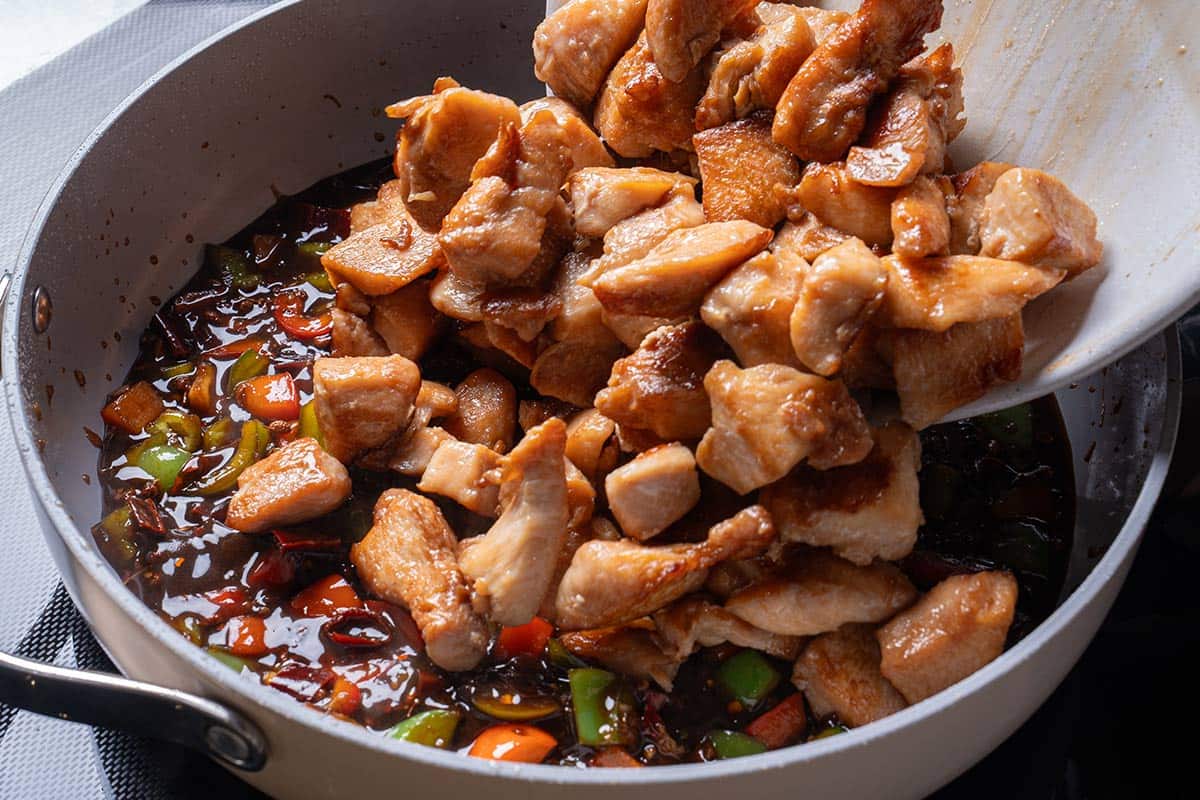This post may contain affiliate links. Please read our disclosure policy.
Kung Pao Chicken is a highly addictive stir-fried chicken with the perfect combination of salty, sweet and spicy flavours!
Make Chinese restaurant quality Kung Pao Chicken in your own kitchen with this easy to follow recipe. With crispy, tender, mouthwatering chicken pieces swimming in the most delicious, silky Chinese sauce, this is one Kung Pao chicken recipe that’ll be hard to pass up!

What Is Kung Pao Chicken
You’ve tried Sweet and Sour Pork, Chicken Cow Mein and Chinese Lemon Chicken, well now it’s time to meet the final boss – Kung Pao Chicken! This Kung Pao chicken recipe has been one of our most requested!
Traditionally, this Chinese chicken dish is a dry-stir fry; not a lot of sauce is added into Kung Pao chicken. However, with the flavour explosions you’ll experience eating this dish, you won’t need or want any more sauce. There’s so much flavour in this dish, it’s crazy!
Ingredients

There are six main ingredients you’ll need to make the perfect Kung Pan chicken:
- Chicken broth or stock (use low sodium) – you can also use water if you don’t have any broth on hand.
- Light soy – use light or low sodium if you can. Regular soy creates an unpleasant, salty sauce.
- Dark soy sauce – adds beautiful colour and flavour to the sauce.
- Hoisin sauce – more depth of flavour!
- Chinese black vinegar – or a good quality balsamic vinegar can be used instead.
- Chinese wine (Shaoxing) – to substitute you can use any of the following: dry sherry, gin, rice wine vinegar, apple cider vinegar.
For the stir fry, I’ve included broth, red and green bell peppers (or capsicums) and the traditional roasted peanuts. You can also add in diced celery, sliced carrots and/or zucchini!
Note: see recipe card at the bottom for full list of ingredients and measurements
How To Make Kung Pao Chicken

- Combine: skinless chicken breast boneless, shaoxing wine or dry sherry, light soy sauce, baking soda, cornstarch & cornflour in a shallow bowl; cover and marinate for 10 minutes (if time allows).

- Whisk: chicken stock, light soy sauce, Chinese black vinegar, Chinese Shaoxing wine or dry sherry, dark soy sauce, hoisin sauce, sugar, cornstarch and cornflour sauce together until sugar dissolves; set aside.

- Heat: a large skillet, pan or wok over high heat. Add 2 tablespoons of cooking oil, allow to heat up, then add marinated chicken. Fry chicken for 3-4 minutes while occasionally stirring, until edges are browned. Remove from heat and set aside.

- Add: remaining cooking oil into the same pan/wok. Stir in garlic, ginger, chili diced peppers (capsicums) and Sichuan peppercorns and stir fry for 1 minute.

- Pour: Give the prepared sauce a mix, then pour the mixture into the pan and bring it to a boil while stirring.

- When: it thickens slightly, add chicken back in and mix all ingredients through the sauce until the chicken is evenly coated and sauce has thickened

- Stir: in green onions, peanuts and sesame oil. Toss well and cook for a further 2 min to infuse flavours.

- Serve: immediately with steamed/cooked rice or fried rice!
I recommend serving your Kung Pao Chicken over a hot bed of white rice, with a side of Five Minute Sugar Snap Peas.
Recipe FAQ’s
Sichuan peppercorns provide the distinctive mouth-numbing heat characteristic of Kung Pao Chicken. While they are traditional and recommended, if unavailable, you can omit them or use other spices, keeping in mind that the unique flavor profile will be altered.
Velveting is a Chinese cooking technique that tenderizes meat. In this recipe, chicken pieces are marinated in a mixture of cornstarch, baking soda, and Chinese wine (or alternatives like sherry, rice wine, or vinegar). This marinade acts as a protective coating, sealing in moisture and preventing overcooking, resulting in tender and flavorful chicken.
The spiciness can be adjusted to your preference. The recipe suggests starting with a smaller amount of Sichuan peppercorns if you’re sensitive to heat and increasing as desired.

You might also like

Get a free eBook!
Subscribe to Cafe Delites FOR FREE and receive recipes straight into your inbox!

Kung Pao Chicken
Ingredients
Chicken:
- 28 ounces skinless chicken breast boneless, cut into 1 inch cubes
- 1 tablespoon shaoxing wine or dry sherry
- 1 tablespoon light soy sauce
- 2 teaspoons baking soda
- 1 teaspoon cornstarch cornflour
Sauce:
- 1/2 cup low-sodium chicken stock or broth – water can be used
- 5 tablespoons light soy sauce
- 2 tablespoons Chinese black vinegar or substitute good-quality balsamic vinegar
- 2 tablespoon Chinese Shaoxing wine or dry sherry
- 2 teaspoon dark soy sauce
- 2 teaspoons hoisin sauce
- 2 tablespoons sugar
- 1 teaspoon cornstarch cornflour
Stir Fry:
- 4 tablespoons cooking oil divided
- 1 1/2 tablespoons garlic 4-6 cloves
- 1 tablespoon ginger
- 1/2 red bell pepper seeded and diced
- 1/2 green bell pepper seeded and diced
- 8-10 dried chilies cut into ½-inch pieces (adjust to taste)
- 1 tablespoon Sichuan peppercorns lightly toasted and ground
- 4 green onion scallion stems, cut into 1-inch pieces
- 1/2 cup roasted unsalted peanuts
- 2 teaspoons sesame oil optional
Instructions
- Combine all ingredients for the chicken in a shallow bowl; cover and marinate for 10 minutes (if time allows).
- Whisk sauce ingredients together until sugar dissolves; set aside.
- Heat a large skillet, pan or wok over high heat. Add 2 tablespoons of cooking oil, allow to heat up, then add marinated chicken. Fry chicken for 3-4 minutes while occasionally stirring, until edges are browned. Remove from heat and set aside.
- Add remaining cooking oil into the same pan/wok. Stir in garlic, ginger, chili diced peppers (capsicums) and Sichuan peppercorns and stir fry for 1 minute.
- Give the prepared sauce a mix, then pour it into the pan and bring it to a boil while stirring.
- Once it begins to thicken slightly, add chicken back into the pan/wok and mix all of the ingredients through the sauce until the chicken is evenly coated and sauce has thickened, (about 2 minutes).
- Stir in green onions, peanuts and sesame oil. Toss well and continue to cook for a further 2 minutes to infuse all of the flavours together.
- Serve immediately with steamed/cooked rice or fried rice!
Notes
Nutrition
Nutrition information is automatically calculated, so should only be used as an approximation.














I used spicy jalapeños and no sugar. It turned out just slightly more tart than I planned, but that ended up being good. I used rice wine vinegar, but didn’t have the wine.
Pan roasted peanuts elevated it.
I’ve made this recipe multiple times now and it never disappoints. I prefer to add the bell pepper after the sauce thickens as I like them to be a little firmer. If you add them before the sauce thickens, they can cook down and get too soft for my liking.
Hi Joe, I’m so pleased to hear that you’ve made the recipe multiple times and it continues to be a success! Your tip about adding the bell peppers after the sauce thickens is fantastic—it’s all about personal preference. Thank you for sharing your experience and for the helpful suggestion. If you ever try more variations or have questions, feel free to reach out. Happy cooking!